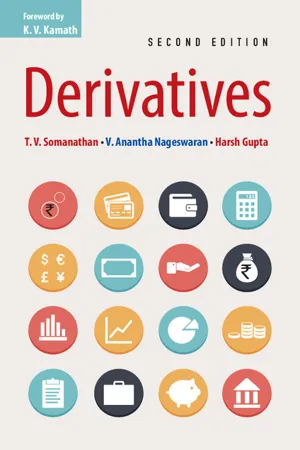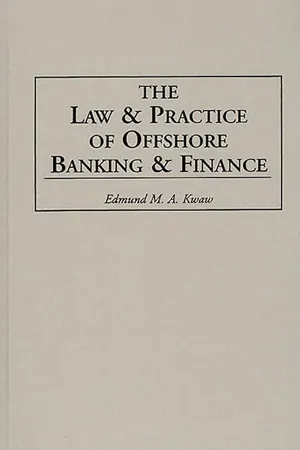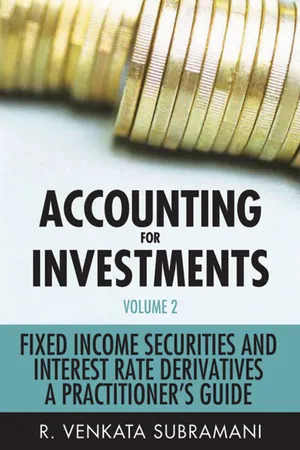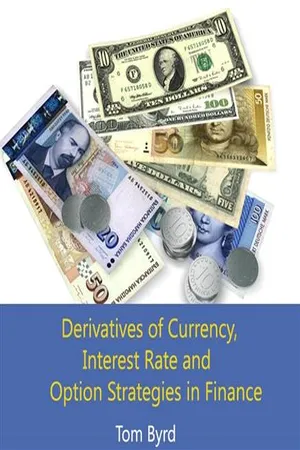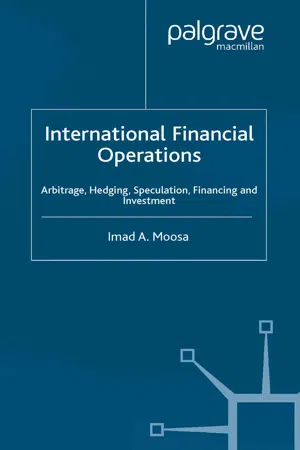Economics
FX Swaps
FX swaps, or foreign exchange swaps, are financial instruments used to exchange one currency for another on a specific date and then reverse the exchange at a later date. They allow parties to manage currency exposure and hedge against exchange rate fluctuations. FX swaps are commonly used by businesses and financial institutions to mitigate foreign exchange risk.
Written by Perlego with AI-assistance
Related key terms
1 of 5
9 Key excerpts on "FX Swaps"
- eBook - PDF
Economics for Investment Decision Makers
Micro, Macro, and International Economics
- Christopher D. Piros, Jerald E. Pinto(Authors)
- 2013(Publication Date)
- Wiley(Publisher)
dollar loan at a known, predetermined exchange rate (the 90-day forward rate). By engaging in simultaneous spot and forward transactions (i.e., an FX swap), the company has eliminated any FX risk from the foreign borrowing. The all-in financing rate using an FX swap will typically be close to that of domestic borrowing, usually within a few basis points. This near equivalence is enforced by an arbitrage relationship that will be described in Section 3.3. On large borrowing amounts, however, even a small differential can add up to substantial cost savings. Another way to hedge FX exposures, or implement speculative FX positions, is to use options on currencies. FX options are contracts that, for an up-front premium or fee, give the purchaser the right, but not the obligation, to make an FX transaction at some future date at an exchange rate agreed on today (when the contract is agreed to). The holder of an FX option will exercise the option only if it is advantageous to do so—that is, if the agreed-on exchange rate for the FX option contract is better than the FX rate available in the market at option expiry. As such, options are extremely flexible tools for managing FX exposures and account for a large percentage of daily turnover in the FX market. 476 Economics for Investment Decision Makers Another concept to bear in mind is that spot, forward, swap, and option products are typically not used in isolation. Most major market participants manage their FX transactions and FX risk exposures through concurrent spot, forward, swap, and option positions. Taken together, these instruments (the building blocks of the FX market) provide an extremely flexible way for market participants to shape their FX risk exposures to match their operational mandates, risk tolerances, and market opinions. Moreover, FX transactions are often made in conjunction with transactions in other financial markets—such as equities, fixed income, and commodities. - eBook - PDF
- Shani Shamah(Author)
- 2003(Publication Date)
- Wiley(Publisher)
For example, the client may have entered into a contract to buy Swiss francs against dollars forward. If, in three months’ time, the dollars do not materialize, the hedge would be extended. This can be achieved using a swap, whereby the original forward is closed out by the spot transaction and the exposure is covered by the forward transaction. 74 A Foreign Exchange Primer CONCLUDING REMARKS Swap risks are almost identical to those for forwards. A swap effectively becomes a forward once the near date has settled. The difference between a forward and a swap is that to do a swap there must be two transactions in opposite directions at different times. 13 Currency Swaps A currency swap is an agreement between two counterparties to exchange future cash flows. There are two fundamental types: the cross-currency swap and the interest rate (single- currency) swap. A cross-currency swap involves the exchange of cash flows in one currency for those in another with an agreement to reverse that transaction at a future date. An interest rate swap changes the basis on which income streams or liabilities are received or paid on a specified principal amount. From a foreign exchange point of view, cross-currency swaps are much more relevant as they allow companies to borrow in the most efficient market, usually one in which the company have not borrowed too heavily in the past. The major difference between cross-currency swaps and currency forwards is that there is only one contract in the case of swaps, whereas forwards require separate contracts for each payment of interest and principal. Figure 13.1 presents, in graphic form, the three stages of a currency swap. 13.1 TECHNIQUE INVOLVED Currency forwards involve amounts of two currencies being exchanged for an agreed period of time and re-exchanged at maturity at the same exchange rate. An interest rate swap is exclusively concerned with the exchange of cash flows relating to the interest payments on the designated notional amount. - eBook - PDF
- T. V. Somanathan, V. Anantha Nageswaran, Harsh Gupta(Authors)
- 2017(Publication Date)
- Cambridge University Press(Publisher)
Part – III Swaps 135 8 Swaps – Part I Interest Rate and Currency Swaps Swaps are contracts in which two separate streams of cash flow are exchanged or ‘swapped’. The streams could be two different kinds of interest amounts, two currencies or indeed any two differing streams of cash. This chapter introduces the conceptual basis of swap contracts and then explains interest rate swaps and currency swaps. The next chapter deals with other types of swaps and some general issues relating to the swaps market. Definition A swap transaction is a contract by which two or more parties exchange (swap) one set of pre-determined payments for another. Some important types of swap are the following: An interest rate swap is an agreement between two parties to exchange interest obligations or receipts in the same currency on an agreed amount of notional principal for an agreed period. A currency swap is an agreement between two parties to exchange payments or receipts in one currency for payments or receipts in another. An equity swap is an agreement between two parties to exchange dividends and/or capital returns on an underlying share with another equity flow or interest flow, in the same or different currencies. Currency swaps slightly predated interest rate swaps, but the latter now predominate in volume. Equity swaps are more recent but growing fast. Swaps can also combine some of the features of interest rate and, say, currency swaps. Thus, a fixed rate payment in dollars might be swapped for a floating rate payment in yen. Such transactions are more complex. A key feature of swaps is that they deal with a set of cash flows involving multiple periods, not a one-time cash flow. This is an important distinction between swaps and futures or options, both of which deal with a single expected cash flow at one specified time in the future. In a swap, invariably there are DERIVATIVES 136 multiple dates involved where one or more income streams would need to exchange hands. - eBook - PDF
- Peter Guangping Zhang(Author)
- 2004(Publication Date)
- World Scientific(Publisher)
Although forward contracts for more than 1 year also exist, they are rather rare. Spot transactions and for-ward contracts are largely for single or less-frequent transactions. For multiple or frequent transactions, foreign exchange swaps are often used. A swap is a financial contract between two parties: one party agrees to pay a fixed rate of a pre-specified notional amount and the other party a corresponding floating rate of the same notional amount for a given period of time with pre-specified frequency. The fixed rate payer is called the buyer and the floating rate payer the seller of the swap. Payment frequencies can be monthly, quarterly, semi-annual, or annual; and notional amounts range normally from a few million to a few hundred million US dollars. The swap market is by far the largest market if we judge by notional amounts, yet only a small fraction of the notional amount, actually the difference between the fixed rate and the corresponding floating rate multi-plied by the notional amount, actually matters in any swap contract. By definition, a swap can be considered as a string of forward contracts because it includes a series of rates to be paid in the future. A foreign exchange swap is a swap with simultaneous exchanges of two currencies on specific dates specified in the contract and a reverse exchange of the same two currencies at a date further in the future at a rate agreed at the time of the contract. Short-term swaps carried out as “tomorrow/next day” transactions are included in this category. Table 8.2 lists the total amounts outstanding of foreign exchange swaps from June 1999 to December 2002. The foreign 112 Foreign Exchange Market and Foreign Exchange Derivatives Market Foreign Exchange Forwards and Swaps 113 exchange swap market somewhat reached maturity as its total amounts outstanding remained between US$8.3 to US$8.9 trillion from June 1999 to December 2002 as shown in Table 8.2. - Edmund Kwaw(Author)
- 1996(Publication Date)
- Praeger(Publisher)
These and other problems led to the demise Swap-Driven Financing in the Eurocurrency Market 177 of the parallel and back-to-back loan forms of financing, and the emergence of the swap. There are two kinds of swap-driven financing, namely the interest rate swap-driven financing and the currency swap-driven financing. Currency swap-driven financing and interest rate swap-driven financing are, generally, the synthetic operations that are achieved when an underlying financing transaction, for example, a loan facility or bond issue is combined with a currency swap or an interest rate swap. It is important to stress that, because of the growth of the swap market, there has been a significant increase in the use of variations of swap products to meet the needs of customers. 2 8.00[2] The Swap and Swap-Driven Financing The swap can be defined in economic as well as legal terms. Some of the literature on swaps adopt an economic approach to defining swaps. 3 In eco- nomic terms the swap could be defined as the exchange of positions or financial cash flows. 4 This economic definition, however, is inappropriate for the pur- poses of this work because it impedes an appreciation of the legal basis of swap financing. Furthermore, such an economic definition distinguishes between the different kinds of swaps, a distinction which may not be completely justified in legal terms. 5 In general legal terms, the swap 6 is a contract between two parties, the counterparties, who agree to exchange or swap amounts comprising their respective obligations, either on debt instruments or on asset instruments, 7 and to make periodic payments comprising the floating or fixed interest payments on their respective obligations to each other. 8 The underlying contract sets out the obligations of the counterparties with respect to the schedule of payments, payments of gross amounts and net margins, and other provisions, such as those providing for termination and default.- eBook - ePub
Accounting for Investments, Volume 2
Fixed Income Securities and Interest Rate Derivatives - A Practitioner's Handbook
- R. Venkata Subramani(Author)
- 2011(Publication Date)
- Wiley(Publisher)
F-47On settlement of interest on pay leg: (T-16 @ FX Rate: 1.5020)F-48 On accounting for FX Translation on settlement of interest on pay leg of XCCY Swap:F-49 On accounting for FX Translation on Bank account:SUMMARY- Currency swaps are over-the-counter derivatives, and are similar to interest rate swaps covered already in this volume except that in a cross-currency swap the principal amounts are in different currencies and unlike interest rate swaps, cross-currency swaps can involve the exchange of the principal.
- Even where there is no exchange of principal, the counterparties are subject to the foreign exchange rate fluctuation during the substance of the trade.
- The tenure of a cross-currency swap typically ranges from one to fifteen years.
- Cross-currency swaps are suitable for entities that have a loan commitment denominated in one currency, while the revenues generated by the entity are denominated in a different currency, resulting in a currency mismatch between the currency of the loan and the currency of revenues.
- A Cross-currency interest rate swaps allow an entity to switch its loan from one currency to another.
- A Cross-currency interest rate swaps enable an entity to manage foreign currency exposures. The entity can use money it receives in one currency to pay off its loans in another currency with a cross-currency swap.
- Since a cross-currency swap is basically an interest rate swap, all the risks associated with an interest rate swap in terms of interest rates do exist in this instrument.
- The single important reason for entering into a cross-currency swap is to manage foreign exchange exposure. This also becomes a huge risk if not managed properly.
- No longer available |Learn more
- (Author)
- 2014(Publication Date)
- Research World(Publisher)
____________________ WORLD TECHNOLOGIES ____________________ frame, involves cash rather than a contract; and interest is not included in the agreed-upon transaction. Forward One way to deal with the foreign exchange risk is to engage in a forward transaction. In this transaction, money does not actually change hands until some agreed upon future date. A buyer and seller agree on an exchange rate for any date in the future, and the transaction occurs on that date, regardless of what the market rates are then. The duration of the trade can be one day, a few days, months or years. Usually the date is decided by both parties. Then the forward contract is negotiated and agreed upon by both parties. Swap The most common type of forward transaction is the FX swap. In an FX swap, two parties exchange currencies for a certain length of time and agree to reverse the transaction at a later date. These are not standardized contracts and are not traded through an exchange. Future Futures are standardized and are usually traded on an exchange created for this purpose. The average contract length is roughly 3 months. Futures contracts are usually inclusive of any interest amounts. Option A foreign exchange option (commonly shortened to just FX option) is a derivative where the owner has the right but not the obligation to exchange money denominated in one currency into another currency at a pre-agreed exchange rate on a specified date. The FX options market is the deepest, largest and most liquid market for options of any kind in the world.. Speculation Controversy about currency speculators and their effect on currency devaluations and national economies recurs regularly. Nevertheless, economists including Milton Friedman have argued that speculators ultimately are a stabilizing influence on the market and perform the important function of providing a market for hedgers and transferring risk from those people who don't wish to bear it, to those who do. - eBook - PDF
International Financial Operations
Arbitrage, Hedging, Speculation, Financing and Investment
- I. Moosa(Author)
- 2003(Publication Date)
- Palgrave Macmillan(Publisher)
However, because of the risk involved, banks only offer these contracts to the most creditworthy customers. Currency swaps Swaps are suitable for hedging a recurrent exposure that consists of a series of payables or receivables. A currency swap resembles a portfolio of forward contracts, whereby two parties agree to exchange two cash flows denomi- nated in two different currencies at a predetermined exchange rate on a sequence of future dates. Suppose that a firm whose base currency is x anticipates a series of receiv- ables (K units of y) arising at points in time 1, 2, 3, ..., n. To hedge this exposure, the firm arranges a swap with a counterparty whereby the firm receives payments in terms of x equal to K converted at the contract rate, S t , while the counterparty receives K units of y. Table 5.8 shows the payments received by the firm and the counterparty at each payment period in both currencies. 5 . 8 F I N A N C I A L H E D G I N G O F L O N G - T E R M E X P O S U R E 137 Payment date The firm receives The counterparty receives Units of x Units of y Units of x Units of y 1 KS t K KS t +1 K 2 KS t K KS t +2 K 3 KS t K KS t +3 K n KS t K KS t n + K TABLE 5.8 Payments involved in a currency swap. Parallel loans Parallel loans (or back-to-back loans) can be used to hedge long-term payables and receivables in exactly the same way as swaps. In this case, however, the exchanged payments are based on the forward rates. 5.9 OTHER FINANCIAL AND OPERATIONAL TECHNIQUES OF HEDGING TRANSACTION EXPOSURE It may not be possible to implement the hedging techniques discussed so far. This may be due, for example, to the inability to forecast the sales resulting from an advertised reduction in prices over the following six months. Another reason is that the hedging costs may be prohibitively high. A third reason is the unavailability of forward, futures or options contracts for the underlying currency. When this is the case the following techniques may be considered. - eBook - PDF
- Alan C. Shapiro, Paul Hanouna(Authors)
- 2019(Publication Date)
- Wiley(Publisher)
As illustrated in Figure 8.2, the two loans that comprise the currency swap have parallel interest and principal repayment schedules. At each payment date, company A will pay a fixed interest rate in dollars and receive a fixed rate in yen. The counterparties also exchange principal amounts at the start and the end of the swap arrangement (denoted as time T in the diagram). In effect, a U.S. firm engaged in a currency swap has borrowed foreign currency and converted its pro- ceeds into dollars, while simultaneously arranging for a counterparty to make the requisite foreign currency 0 time 1 2 3 T Dollars Yen Yen Yen Yen Dollars Dollars Yen Yen Dollars Dollars Dollars Company B Company A Figure 8.2 Diagram of a fixed-for-fixed currency swap 222 CURRENCY, INTEREST RATE, AND CREDIT DERIVATIVES AND SWAPS payment in each period. In return for this foreign currency payment, the firm pays an agreed-upon amount of dollars to the counterparty. Given the fixed nature of the periodic exchanges of currencies, the currency swap is equivalent to a package of forward contracts. For example, in the dollar:yen swap just shown, firm A has contracted to sell fixed amounts of dollars forward for fixed amounts of yen on a series of future dates. The counterparties to a currency swap will be concerned about their all-in cost—that is, the effective interest rate on the money they have raised. This interest rate is calculated as the discount rate that equates the present value of the future interest and principal payments to the net proceeds received by the issuer. Currency swaps contain the right of offset, which gives each party the right to offset any nonpayment of principal or interest with a comparable nonpayment. Absent a right of offset, default by one party would not release the other from making its contractually obligated payments. Moreover, because a currency swap is not a loan, it does not appear as a liability on the parties’ balance sheets.
Index pages curate the most relevant extracts from our library of academic textbooks. They’ve been created using an in-house natural language model (NLM), each adding context and meaning to key research topics.


